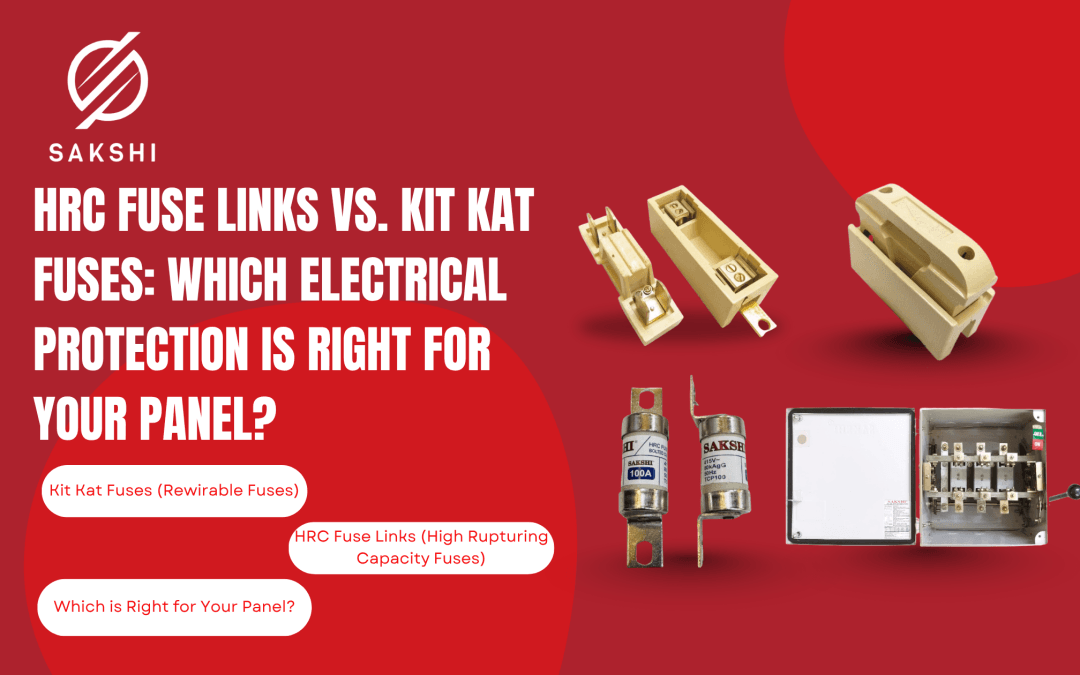When it comes to safeguarding your electrical panel, choosing the right fuse is paramount. In India, two common types often come up in discussion: HRC (High Rupturing Capacity) fuse links and the more traditional “Kit Kat” fuses (rewirable fuses). Both serve the vital purpose of protecting your circuits from overcurrents and short circuits, but they do so with significant differences in performance, safety, and application.
At Dhiraj Electrical India, we believe in empowering our customers with the knowledge to make informed decisions. Let’s dive into a comparison to help you determine which electrical protection is right for your panel.
Understanding the Basics
Kit Kat Fuses (Rewirable Fuses)
The “Kit Kat” fuse gets its colloquial name from its shape, resembling the popular chocolate bar. These are traditional rewirable fuses, meaning that when the fuse wire melts due to an overcurrent, it can be replaced with a new one of the correct rating.
- How they work: A thin wire (typically copper or tinned copper) of a specific gauge is placed within a porcelain carrier. When an overcurrent flows, the wire heats up and melts, breaking the circuit.
- Advantages:
- Cost-effective: Initial purchase cost is generally lower.
- Rewirable: The ability to replace just the fuse wire can be seen as an advantage in terms of immediate repair.
- Disadvantages:
- Low Breaking Capacity: They are not designed to safely interrupt very high fault currents that can occur during a severe short circuit. This can lead to arcing and potential damage to the fuse unit or panel.
- Inaccurate Protection: The actual rupturing current can vary depending on the quality and gauge of the replacement wire, leading to inconsistent protection.
- Risk of Over-fusing: Users might be tempted to use a wire of a higher rating than specified, defeating the purpose of the fuse and creating a significant fire hazard.
- Slower Operation: They tend to operate slower than HRC fuses under fault conditions.
- Safety Concerns: Exposure to live parts during rewiring can pose a shock hazard.
HRC Fuse Links (High Rupturing Capacity Fuses)
HRC fuse links are a more modern and sophisticated form of electrical protection. They are designed to safely interrupt extremely high fault currents without arcing or exploding, making them far safer and more reliable.
- How they work: An HRC fuse consists of a fuse element (often silver or copper) enclosed in a sealed, heat-resistant body (usually ceramic) filled with a granular quartz powder. When an overcurrent flows, the fuse element melts, and the quartz powder rapidly absorbs the arc energy, safely extinguishing it.
- Advantages:
- High Breaking Capacity: This is their defining feature. HRC fuses can safely interrupt very large fault currents, protecting equipment and personnel from severe damage.
- Reliable & Accurate Protection: They offer precise and consistent protection as their breaking characteristics are fixed by design and manufacturing.
- Non-Deteriorating: Their characteristics do not change over time under normal operating conditions.
- Fast Operation: They clear fault currents very quickly, minimizing damage to the protected circuit.
- Safe Operation: Being fully enclosed, there is no risk of external arcing or exposure to live parts during a fault. They also have indicator systems to show when they’ve blown.
- Tamper-proof: They cannot be easily “over-fused” like rewirable fuses.
- Disadvantages:
- Higher Initial Cost: HRC fuses are more expensive than Kit Kat fuses.
- Non-Rewirable: Once blown, the entire fuse link must be replaced.
Which is Right for Your Panel?
The choice between HRC fuse links and Kit Kat fuses largely depends on the specific application, the level of safety desired, and the potential fault current levels in your installation.
- For residential applications with older wiring or very limited budgets: Kit Kat fuses might still be found, but their use is increasingly discouraged due to safety concerns and limitations. If your home still uses Kit Kat fuses, it’s strongly recommended to consider upgrading your protection.
- For modern residential, commercial, and industrial applications: HRC fuse links are the clear winner.
- Safety First: Their ability to safely clear high fault currents provides superior protection against fire hazards and equipment damage.
- Reliability: You can count on HRC fuses to perform as intended every time.
- Compliance: Many modern electrical codes and standards recommend or mandate the use of HRC fuses due to their enhanced safety features.
- Protection of Expensive Equipment: In commercial and industrial settings, where machinery and equipment are valuable, the superior protection offered by HRC fuses is invaluable.
At Dhiraj Electrical India, we strongly advocate for the use of HRC fuse links for all new installations and recommend upgrading existing panels where Kit Kat fuses are still in use. While the initial investment may be slightly higher, the enhanced safety, reliability, and peace of mind offered by HRC fuse links far outweigh the cost difference.
Don’t compromise on electrical safety! Consult with a qualified electrician to assess your panel’s needs and ensure you have the appropriate protection in place. For high-quality HRC fuse links and all your electrical protection requirements, trust Dhiraj Electrical India.
Contact us today to learn more about our range of electrical safety solutions!



